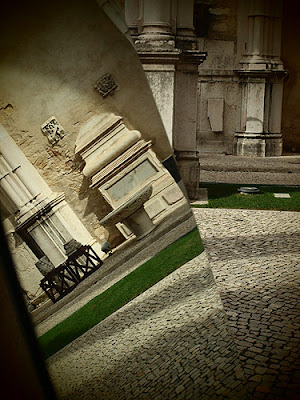We stopped a trio of students (who were dressed as cats) and asked our feline friends for directions. They pointed us towards the nearest metro station, which was a 10-minute walk uphill in a steady drizzle. We had no idea what to expect from the subway service after midnight on Halloween, but it turned out to be the busiest we'd ever seen it, with the carriages packed with students in full costume. Thankfully we escaped the zombie horde without any trouble and made it back home by 1am.
The day after Halloween is All Saints Day. It was on the morning of 1st November in 1755, while most of Lisbon's population were attending mass, that a ferocious earthquake shook the city which must have measured at least 8.5 on the Richter scale. Several churches, filled to bursting with worshipers observing mass, collapsed. The hundreds of candles lit for the All Saints services contributed to fires which spread across the city. Thousands of people escaped the fire by fleeing to open spaces along the riverfront or by boarding ships, but within the hour three successive tsunamis raced up the river, causing boats to capsize, more buildings to collapse and pulling people out to sea.
The waves also decimated the Algarve coast in the south of Portugal (where the waves were 90 feet high) and affected the seaside as far away as Ireland, Morocco and the Caribbean.
At the time, Lisbon was one of the largest and richest cities in Europe, home to at least a quarter of a million people. It was about five days before the fires in the city were brought under control and no-one will ever know how many people died in the catastrophe.
The royal family narrowly missed the earthquake by leaving the city after an early morning mass; the king could never bring himself to stay inside four walls again and housed his court under tents on the outskirts of the city for the remainder of his reign. Practically all of Lisbon was reduced to rubble and a new city had to be built, along a grid plan.
The ruins of a church overlooking the new downtown have been preserved in part as a memorial to the disaster. The original Carmo Convent was established in 1389 and attempts to restore it after the earthquake were abandoned. In the 1800s it became home to what is now the national association of archaeologists, whose collection of numerous stone carvings and other artefacts is open to visitors.
The main body of the former church is an open-air museum.
Tombstones, sculptures and inscriptions lied scattered under the skeletal arches of the ruined convent, together with a few original features of the church like this extravagant tomb.
A few side chapels were rebuilt and now house a small but intriguing collection that ranges from Egyptian mummies to Roman tombs and from Aztec statues to English alabaster.
It probably only took a half hour to explore, but as you can see there were plenty of photo opportunities and the small admission charge (€3.5 at the time) was well worth the price.













No comments:
Post a Comment